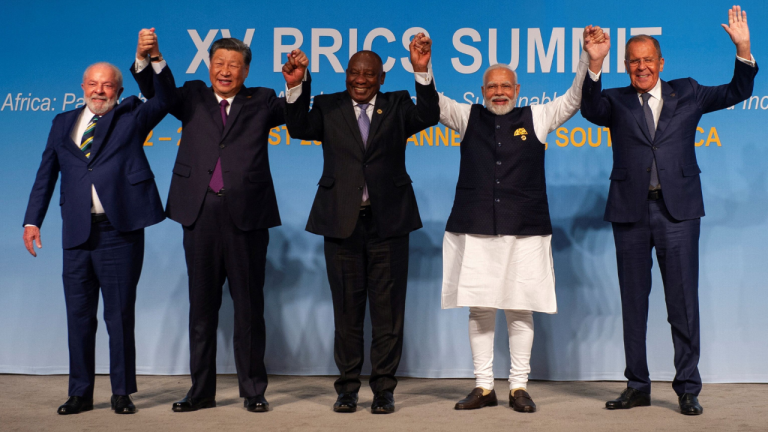BRICS is an acronym that stands for Brazil, Russia, India, China, and South Africa. Originally, the idea for the group was created by Jim O’Neill, a Goldman Sachs analyst, when he wrote about emerging economies. O’Neill predicted that the BRICS countries’ GDP growth had the possibility of surpassing the ones of the G7 countries (Canada, France, Germany, Italy, Japan, the United Kingdom, and the United States) , a group made up of only advanced economies. The group allied in 2006. At the time, it was only called BRIC, as South Africa only joined in 2011, therefore changing the acronym with the extra S. BRICS countries’ leaders meet annually to discuss issues related to changing the political and economic landscape in ways that will benefit their interests and help the countries grow and eventually become developed nations. This year, in 2023, the BRICS summit happened in Johannesburg, South Africa. It was one of the biggest conferences ever held, with several other countries being present while asking to join the group in hopes of expanding their chances of economic development.
This year’s summit was not only a big reunion, but one of its most important highlights was a new agreement that will be put in place, stating that the BRICS group will accept six new members, including Argentina, Egypt, Ethiopia, Iran, Saudi Arabia, and the United Arab Emirates, all of which are predicted to join the group at the beginning of 2024. The expansion of the group reflects on the futures of both the current and the future group members, allowing for BRICS countries to possibly achieve more global influence. The expansion of the group to BRICS+ and the adoption of new guiding principles, standards, and procedures have the potential to turn the group into a more attractive institution for the development of the countries and power of influence over the world.
The countries in the bloc account for more than 42% of the world’s population, 30% of its territory, 23% of global GDP, and 18% of global trade. However, the percentage that applies to the internal trades within the BRICS components is only about 6%. The 2023 BRICS Submission was the first held in person, where 40 countries have demonstrated interest in being a member of the group, and 23 of them have formally applied to take the chance of committing. The six invited nations will be joining as full members of the group on January 1, 2024, and it is important to note that the BRICS union has a considerable population of 3.7 billion people. Expanding its power, the bloc has the intention of reshaping governance as “multipolar,” putting the Global South in a significant spotlight. In addition, As Chinese President Xi Jinping stated, “This membership expansion is historic.” since countries have been thinking about expanding for more than a year, and the new members were invited this week after an agreement was reached at the reunion (Ismail Al Jazeera). From Russia and China, things were seen a little differently since they were the ones who pushed more closely for the process of making BRICS bigger with all of the pushback from Western nations in the form of sanctions they are facing.
One considerable aspect is that the BRICS+ system is headed beyond traditional alliances and partnerships, especially in the eye of the West, with Iran as a new member. Another significant point is how these partners will add and participate in the new cooperation systems; India and UAE, the world’s major commodities importers and exporters, are likely to reduce their dependence on the United States, for instance. BRICS+, if not a new world order, is certainly an attempt to develop a more sympathetic world to countries in development versus the developed ones. On the other hand, additional memberships require new layers of complexity, as well as more challenges regarding consensus between countries involved in this group. BRICS+, apart from Russia, have no intentions of being anti-West; therefore, given the direction that was taken, they are alt-West. Furthermore, each of the member countries is free to develop their own relationship with the US and Europe as long as they prioritize their relationship with each other. Overall, because of their combined rejection of the US and European imposed restrictions on other countries’ foreign policy and economic activities, the BRICS space can be the key to diversifying the world and entering a more multi-faced scenario.



